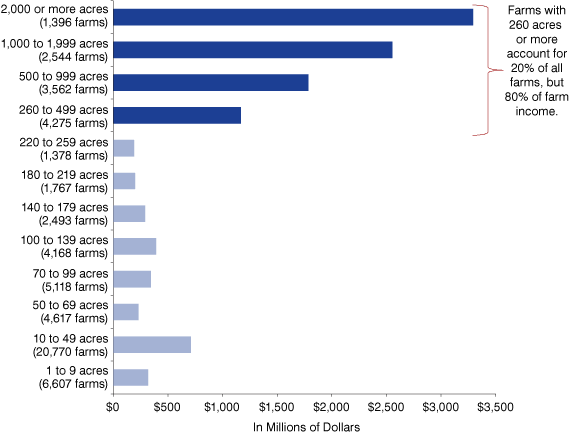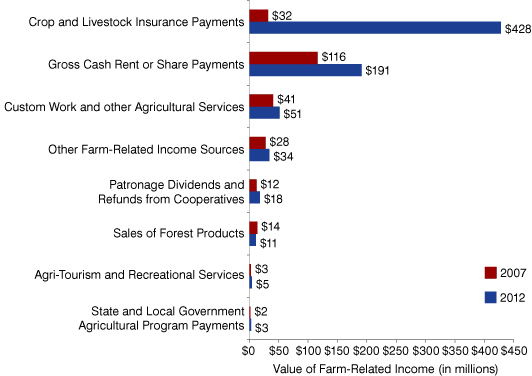Farm Financials
In early May, the U.S. Department of Agriculture’s (USDA) National Agriculture Statistics Service (NASS) released the results from the 2012 Census of Agriculture. This release provided researchers a treasure trove of data to analyze in order to better understand the agriculture industry.
Who Completes the Survey?
In late December 2012, 3 million questionnaires were sent out to agricultural producers throughout the nation. Similar to the national Census, multiple efforts were used to solicit responses, including mail, Internet, phone and in-person visits.
The USDA defines a farm as any place that produced and sold, or normally would have sold, $1,000 or more of agricultural products during the Census year. Thus, farming operations of all sizes and types were sought to participate.
Due to the vast amount of interesting data, InContext is publishing a mini-series on the Census of Agriculture results. This article serves as the second installment concentrating on farm finances and management. (See the first article for highlights of the Census results).
Record Levels
Nationally, agricultural sales were at record levels for both crop and livestock sectors in 2012. Compared to the 2007 Census of Agriculture, farm income was higher, yet so were production expenses. Unfortunately, not all sectors had increased incomes and the winners and losers were often concentrated geographically or by farm category or industry.
For the second time in census history, crop sales exceeded livestock sales nationally.1 Within Indiana, crop sales also exceeded livestock sales, but both categories experienced strong growth since 2007.
The surge in crop sales is likely attributable to high corn and soybean prices due to the dramatic drought that afflicted many of the crop-producing states in 2012. Indeed, the corn and soybean yield in 2012 was substantially smaller than 2013’s bountiful crop. The drought caused farmers to have a record crop insurance payout year, which helped buoy their operations—at least for the 75 percent that purchased coverage. While much of the attention in 2012 was given to the corn and soybean growers whose yields withered in the heat, livestock producers and other agricultural sectors were also affected.
Agricultural Sales
Nationally, U.S. farms sold approximately $395 billion in agricultural products, a 33 percent increase over 2007. Indiana’s farms sold $11.2 billion, a 35.5 percent increase since 2007 (see Table 1). Among all states, Indiana ranked 10th in its agricultural sales as it contributed 2.8 percent of the national total. As expected, grains comprised the bulk of the state’s agricultural goods in terms of market value (95.9 percent).
The only sector that witnessed a decline in market value was in the "all other" category for crops—which included fruits and vegetables, floriculture, woody forest products and tobacco. More information on the state’s production quantities, values and geographic concentrations will be provided in the next and final article about the 2012 Agriculture Census.
Table 1: Indiana’s Market Value of Agricultural Products, 2007 and 2012
| Sector | 2007 | 2012 | Percent Change |
|---|---|---|---|
| (in billions) | |||
| All Products | $8.3 | $11.2 | 35.5% |
| Crops | $5.3 | $7.5 | 41.6% |
| Grains | $5.0 | $7.2 | 43.7% |
| Fruits and Vegetables | $0.1 | $0.1 | 17.8% |
| All Other | $0.2 | $0.2 | -1.5% |
| Livestock | $3.0 | $3.7 | 24.7% |
| Cattle and Calves | $0.5 | $0.5 | 14.5% |
| Pigs and Hogs | $1.0 | $1.3 | 30.7% |
| Poultry | $0.9 | $1.2 | 31.2% |
| All Other | $0.6 | $0.7 | 13.7% |
Source: IBRC, using 2012 Census of Agriculture data
As can be expected, the larger the farming operation, the greater share of the state’s total market value and government payments it receives. Likewise, these operations have tremendous expenses due to the sheer volume of goods they need, as well as investments to maximize efficiency. Figure 1 breaks down by farm size the market value and government payments received (along with the number of farms in each category). Here one clearly sees the Pareto principle, otherwise known as the 80-20 rule. Roughly 80 percent of the state’s agriculture income from market and government payments came from 20 percent of the farming operations.
Figure 1: Indiana’s Market Value and Government Payments by Farm Size, 2012

Source: IBRC, using 2012 Census of Agriculture data
The Balance Sheet: Income and Expenses
It takes a strong stomach to witness the large sums of money associated with the inputs and outputs of farming operations, all of which are typically at the mercy of the weather. In recent history, farm operators have had relatively high market prices for their products, yet the margins remain narrow due to rising expenses.
Income
The market values of agricultural products are the primary income sources for the farming operation; however, other sources of farm income do exist. Examples of other farm income include government payments (crop and livestock insurance and subsidy programs), agri-tourism, custom work and sales of forest products.
Government Payments
Government payments to farmers include payments for disaster, loan deficiencies, conservation, as well as other federal programs. The 2012 census data reflects programs in effect from the 2008 farm bill. Nationally, 38.6 percent (811,387) of farmers received a total of $8.1 billion in government payments from federal farm programs. Fewer farms received payments (3 percent), yet payments increased by 1 percent. The most notable change occurred in fewer farmers electing to participate in conservation programs, so payouts in this area declined.
Within Indiana, these national trends held true, with 10.5 percent fewer farms receiving government payments despite a 2.5 percent increase in payouts. The conservation program was the primary source of lost participation and payouts.
Farm-Related Income
In 2012, Indiana had an astronomical surge in crop and livestock insurance payments relative to 2007 (1,239 percent), as shown in Figure 2. When looking at 2007 figures, one will notice that crop and livestock insurance payments was the third highest farm-related income source, thus solidifying the fact that it’s not typical for producers to collect large sums of insurance payouts. The second largest farm-related income in 2012 (the top source in 2007) was cash rent or share payments, which increased 64 percent since 2007.
Farm ground is considered a valuable investment and often serves as a steady and lucrative income source. It may seem perplexing as to why this income source would be present considering that many farmers consider it an expense. One must keep in mind that it’s not uncommon for the principal operator to retain ownership of the farm ground while another operator pays rent to farm it. A perfect example would be an elderly widow whose husband was a farmer (thus the farm is still in her name). She is not able to farm; therefore, she rents it out to her son (who has his own farming operation). Therefore, the elderly woman considers cash rent as an income, whereas the farmer considers it an expense.
Figure 2: Indiana’s Farm-Related Income Sources, 2007 and 2012

Source: IBRC, using 2012 Census of Agriculture data
Expenses
Between 2007 and 2012, production expenses increased 36.4 percent nationally and 45.2 percent statewide. Table 2 shows that feed, fertilizer and cash rents were the top three expenses for Indiana’s farmers, of which the average increase was 52.8 percent since 2007. The expenses with the most change during the census years were custom work (104.3 percent), seeds (80.2 percent) and fertilizer (62.6 percent). Of the production expenses categories depicted, Indiana has experienced stronger growth in eight of them with the most dramatic difference being between custom work and seeds.
Table 2: Indiana’s Production Expenses, 2007 and 2012
| Category | Expenses (in millions) | Percent Change | ||
|---|---|---|---|---|
| 2007 | 2012 | Indiana | U.S. | |
| Total | $6,281 | $9,117 | 45.2% | 36.4% |
| Feed | $1,092 | $1,592 | 45.8% | 54.2% |
| Fertilizer | $888 | $1,444 | 62.6% | 57.6% |
| Cash rent | $702 | $1,052 | 49.9% | 58.2% |
| Seeds | $515 | $928 | 80.2% | 66.0% |
| Livestock and poultry purchases | $511 | $509 | -0.5% | 9.4% |
| Supplies and repairs | $424 | $523 | 23.5% | 18.7% |
| Chemicals | $374 | $564 | 50.9% | 63.4% |
| Hired and contracted labor | $352 | $487 | 38.3% | 26.8% |
| Gasoline, fuels and oils | $344 | $458 | 33.0% | 28.4% |
| Property Taxes | $208 | $261 | 25.6% | 19.4% |
| Custom work | $63 | $128 | 104.3% | 61.6% |
| Other | $808 | $1,171 | 44.9% | 24.0% |
Source: IBRC, using 2012 Census of Agriculture data
Bottom Line: Net Cash Farm Income
Despite all of the changes in market values, farm incomes and production expenses, the most important measure to farmers (and any business person, for that matter) is the bottom line. Net cash farm income is the amount an operation receives from agricultural sales, government payments and farm-related income after expenses. Here the figures can be reported at a high level—for all farms in a given region—or at a more understandable level: a per farm average.
Nationally, the net cash farm income in 2012 was $92.3 billion, an increase of 23.7 percent, which is statistically significant. In Indiana, these figures were $3.1 billion, an increase of 24.2 percent.
The 2012 per farm average in the U.S. was $43,750 vs. $52,861 in Indiana. In reporting the per farm average, one must realize that the average greatly obscures the range in net cash farm income earned in the state. When a farmer has a net cash farm income, they can choose to roll it into the next farming season’s expenses (such as seed, feed, fertilizer, etc.), save it and/or spread the wealth around through non-farm purchases. The ripple effect of such actions within Indiana’s agricultural industry was documented in a report titled “Agriculture’s Bounty: The Economic Contribution of Agriculture.”
Summary
Some may view the farming occupation as an idyllic one, but in reality, farming is a capital intensive occupation within a high-risk and stressful environment. It is high-risk because farmers are at the mercy of the weather and the markets. The stress has been enhanced with the advent of technology that allows farmers to continuously check the markets and weather, prompting continuous decisions on whether to buy or sell their inputs and outputs. Managing expenses and selling at the high points of the market is the key to helping these farmers attain positive net cash farm incomes at the end of a farming year.
Stay tuned for the final article in this series, which will delve into the production and market value of Indiana’s agricultural products.
Notes
- USDA’s NASS published an informative farm economics document using 2012 Census of Agriculture data at the national level: www.agcensus.usda.gov/Publications/2012/Online_Resources/Highlights/Farm_Economics/.
